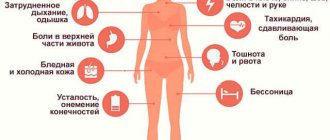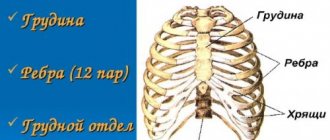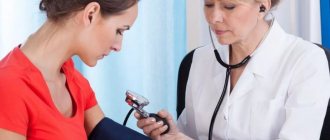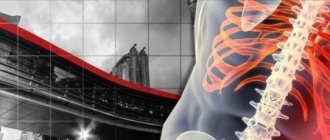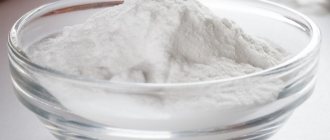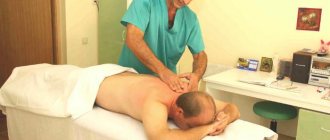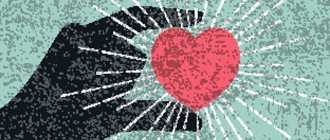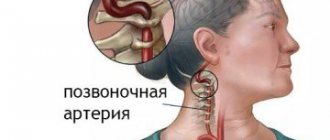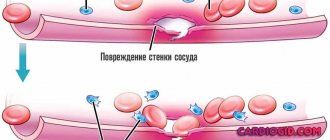Upon reaching the age of 30-35 years, a person is often bothered by unpleasant pain in the area of the heart, which appears seemingly for no reason. Pain can occur with deep breaths, active movements, be constant or periodic, sharp and dull, radiate to the arm, cause difficulty breathing. It is important to understand what caused the pain syndrome and take the necessary measures, more on this in the article below.
Since childhood, we are taught to be very attentive to any manifestations of discomfort that arise in this area, so the symptom that appears is very frightening. In fact, there are quite a few causes of pain in this area.
In addition to the heart muscle, which is the first thing you think about, there are manifestations of spinal curvature, intercostal neuralgia, as well as the stomach, spleen and other abdominal organs. If we are talking specifically about the heart, then most likely there is coronary disease, hypertension and others.
Causes of pain syndrome
Sharp pain under the left breast can be caused by damage to the pancreas, intestines, stomach, cardiovascular system, spleen, or may be caused by osteochondrosis.
If a person has pain on the left under the chest, the following diseases may be the cause:
- An infarction developing due to thrombosis of a splenic vessel.
- Ischemic heart damage.
- Endocarditis.
- Cyst, injury, twisted leg, abscess on the spleen.
- Enlargement of this organ or its rupture.
- Aching pain under the left breast occurs with diseases of the small intestine. A dull pain appears in the upper left.
- Acute pain may occur with a gastrointestinal ulcer.
- If a person has gastritis, the left upper quadrant may hurt. The pain in this case is bursting in nature.
- Pain under the left breast from below or in the left side of the back with the development of a hiatal hernia on the diaphragm.
- Stitching pain under the left breast develops with acute heart attack, ischemia, angina pectoris, pericarditis (in the acute form of the disease). Similar pain can occur with osteochondrosis.
- Damage to the mitral valve can cause aching, mild pain in the left upper quadrant.
- The patient's left side of the chest hurts due to intercostal neuralgia.
How to understand whether your heart hurts or not?
After the appearance of pain in the chest, the first thing you should do is figure out and understand what its cause is, whether it is cardiological or non-cardiological.
When the heart or its vessels are susceptible to disease, pain on the left side is called cardiac and the following symptoms are distinguished:
- Location: behind the sternum, to the left border of the clavicle
- The type of pain is very different: aching, pressing, stabbing, dull
- No pain between the ribs or in the spine area
- Pain of cardiac origin is not associated with light physical activity, such as raising and lowering the arms, but occurs after physical activity
- Angina occurs as a result of eating a large amount of food and, for example, active walking after that. It is important to note that there will be no heartburn, belching or bowel irregularities.
- It often radiates to the left hand, the lower jaw on the left, is localized in the left shoulder blade, but there are no sensory disturbances, the left hand does not feel cold, there is no weakness, the skin color is normal.
Signs of tenderness under the left sternum
Since pain can occur due to various ailments, symptoms usually manifest themselves in the form of somatic pain that occurs during inflammatory processes. Such pain signals can be clearly localized, and the patient complains to the doctor of sharp pain that increases with exercise or movement.
When the gastrointestinal tract is affected, the nature of the pain is aching, and the patient complains of a dull pain in the left side of the body.
Often pain sensations are transmitted from the diseased organ to other parts of the body. This usually happens with pneumonia or osteochondrosis.
Mild pain is felt by a person when muscles, skin, intercostal, and nerve endings are damaged. If the pain syndrome is sharp (dagger-like) in nature, then usually these are symptoms of perforation of the stomach wall, damage to the small intestine, renal pelvis, or the person has a ruptured spleen. Then you should immediately seek medical help.
Sharp pain under the left breast can be caused by damage to the pancreas, intestines, stomach, cardiovascular system, spleen, or may be caused by osteochondrosis
If the patient feels pain during a deep breath, various internal organs may be injured. This usually happens during an accident.
With cholecystitis, gastritis and other ailments of the stomach in the upper left, aching pain occurs due to chronic processes of inflammation in the organ.
With heart disease in the left upper quadrant, the patient develops constant, aching and pressing pain. This is usually a sign of a heart attack or angina. Medicines do not help the patient, so you need to see a doctor. Only a complete examination of the patient can accurately determine the cause of the pain syndrome.
Aching nature of pain
If the pain syndrome occurs in a mild form, this often indicates the development of chronic inflammatory processes. Possible inflammation of the stomach, which occurs in slow motion, pathologies of the large intestine, disorders of the spleen. In this case, along with such pain, nausea and vomiting appear. This violation indicates the development of a stomach ulcer.
Symptoms of a stomach ulcer
Important! Often, chronic aching pain signals ischemia or angina. In rare cases, with pathologies of the pancreas, the pain has a girdling character.
If you experience discomfort after stress or physical activity, you may develop cardiac disorders, for example, myocarditis. If even a slight pain syndrome is detected, you should consult a doctor and perform a set of diagnostic examinations.
Diagnosing the causes of pain under the left sternum
The examination is carried out using complex methods. First, the patient is asked about the nature of the pain that is bothering him, and an anamnesis is collected (this also includes heredity). Then the sternum is palpated. The patient's blood pressure, pulse, and temperature in different parts of the body are measured. After this, the person's reflexes are checked.
The patient is then sent for a chest x-ray. An X-ray examination of the patient's skeletal system or organs may be necessary.
An electrocardiogram is done, and then the heart is examined using ultrasound equipment. Pulmonary angiography may be required.
Doctors often use methods such as computed tomography and magnetic tomography for examination. At the same time, laboratory tests are performed on the patient’s urine, blood, and exudate.
Attempts by patients to make a diagnosis themselves are doomed to failure, since any error in diagnosis can lead to worsening of the disease and death of the patient. Therefore, it is best to go to the clinic and let experienced specialists carry out the diagnosis.
Diagnostics
Colitis in the sternum is a symptom that can appear on the left, right, or in the middle. The symptom requires diagnosis, as it allows you to determine the exact cause of its appearance.
The examination includes the following methods:
- general blood and urine analysis - procedures make it possible to identify the value of important indicators (hemoglobin, red blood cells, etc.);
- coprogram - a study of feces, which allows you to study their chemical composition and physical properties;
- electrocardiography (ECG) – a method based on recording the electrical activity of the heart;
- Ultrasound examination (ultrasound) of the heart, abdominal cavity - using the procedure, deviations in the size of organs are detected;
- coronary angiography is a method of studying the coronary arteries of the heart using x-rays;
- myocardial scintigraphy - the method allows you to assess the blood supply to the heart;
- chest x-ray – the result is an image of the organ, which can be used to determine the presence of pathologies;
- computed tomography (CT) - an examination based on X-rays, the procedure results in three-dimensional images of the area being examined;
- magnetic resonance imaging (MRI) - a method based on electromagnetic radiation; the results of the procedure produce three-dimensional images of the area under study;
- mammography - examination of the breast;
- bronchoscopy is a method of examining the respiratory tract;
- biopsy - a small piece of tissue is taken from the affected organ and sent to the laboratory, as a result, pathology is detected;
- gastroscopy - a method of examining the esophagus, stomach and duodenum;
- esophagomanometry - using the procedure, the contractile activity of the esophagus is assessed.
Diagnostic costs may vary. It all depends on the list of procedures, city, organization. Therefore, the price must be clarified at the clinic. You can get diagnosed for free. To do this, you need to go to a clinic with a compulsory health insurance policy (CHI).
Treatment of pain under the left sternum
The treatment process depends on the established diagnosis. If the pain is acute, then it is stopped, and then a course of therapy is started. To do this, first exclude life-threatening cases such as splenic rupture, aortic aneurysm or myocardial infarction.
If the patient is over 40 years old, he is hospitalized in order to reduce the risk of developing acute conditions. It is prohibited to use narcotic substances or other strong analgesics for this disease if a person has a pathology in the gastrointestinal tract. Relieving pain with strong drugs can mask the true cause of the disease.
Treatment options
Treatment also depends on where the pain is located and what caused it. The following groups of drugs can be used:
- Sedatives: Valocordin, Carvalol, tincture of valerian or motherwort.
- Painkillers or anti-inflammatory drugs: Analgin, Aspirin, Nurofen, Paracetamol.
- Nitrogen-containing: Nitroglycerin.
After diagnosis, depending on the type of disease, vitamins, hormonal medications, analgesics or antibiotics may be prescribed. In some cases, massage and therapeutic exercises may be required; if conservative treatment is ineffective, the doctor will prescribe surgical intervention.
Prevention of the described disease
To prevent a person from suddenly developing pain under the left sternum, he must undergo a standard medical examination once a year. Preventive measures for the early detection of lesions of the cardiovascular system consist of taking medications prescribed by a doctor. You cannot voluntarily stop taking these medications after a person’s condition improves. This can only be done after consultation with your doctor.
It is recommended to completely stop drinking alcoholic beverages and smoking. It is necessary to coordinate your daily diet with your doctor, removing from it those foods that can worsen heart disease. The patient should not engage in heavy physical labor. He should always have medications like nitroglycerin with him to relieve pain.
If the disease is associated with the development of osteochondrosis, then for prevention it is necessary to engage in physical therapy and swimming. Your doctor may prescribe medications to relieve pain.
If the mammary gland is affected, a woman should be constantly examined, since surgery may be necessary at any time.
Prevention of pain under the left sternum does not involve specific measures, since it all depends on the cause of the disease.
Other causes of pain
In addition to the reasons listed above, pain can also occur due to other conditions, among which are:
- Neoplasms. Lung cancer is a constant pain when breathing, its nature is burning.
- Shingles. The disease is of infectious origin. A few days before the rash appears on the body, discomfort appears when inhaling
- Klepatura. After physical activity, painful sensations appear in the muscle area. This cannot be classified as a disease, even though there is pain when inhaling.
- Chest injury - appears after a fall or bruise. Soft tissues swell and there is pain when inhaling. In order to exclude a fracture, it is necessary to take an x-ray.
- Rib fractures. The pain that makes itself felt most strongly is not during inhalation, but when coughing. Pain is also present during palpation.
- Intercostal neuralgia. Symptoms of this disease can cause the patient's mobility to be limited.
There are a lot of reasons that can cause chest pain during inhalation, and as you can see, many of them are not as harmless as they may seem at first glance.
When to call an ambulance
Depending on the progression of the disease, the condition can get very worse
If the symptoms listed below appear, you should call an ambulance as soon as possible:
- along with the pain there is a feeling of squeezing, shortness of breath, the pain spreads to neighboring parts of the body;
- the heartbeat quickens, the head becomes dizzy, nausea occurs, the skin turns gray, cold sweat runs through the body, and the person loses consciousness.
If the condition does not improve after taking medications, and the pain lasts more than twenty minutes, it is also recommended to call an ambulance.

